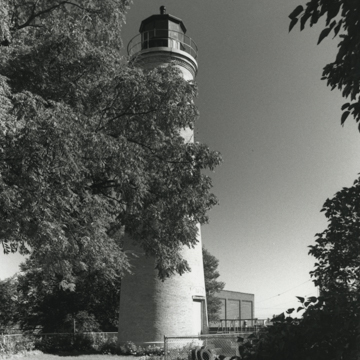A sentinel on a lakeside bluff, the Kenosha lighthouse guided ships into port for almost forty years. The cream brick tower rises fifty-five feet from a stone base, its tapering walls ending in a corbeled sawtooth cornice. An iron deck and railing ring the recently reconstructed lantern. Inside the tower, a cast-iron staircase with diamond-patterned treads, open-arch risers, and fleur-de-lis brackets spirals up to the lantern and its fourth-order Fresnel lens. The keeper lived in the adjacent cream brick Greek Revival house.
Lighthouse building was part of a failed campaign to make Kenosha a major port, but Chicago, Milwaukee, and Racine offered superior harbors and railroad connections. Nevertheless, from the 1830s to the 1880s, local residents and federal agencies poured money into improving Kenosha’s harbor facilities, including its lighthouses. In 1840 they replaced a makeshift structure with a more substantial one, superseded by a new lighthouse on Simmons Island in 1848. Finally, in 1866 the federal Lighthouse Board erected the present tower as part of its effort to create a comprehensive, nationwide network of navigational aids. This lighthouse was too far from the harbor, as pierhead beacons served ships much better. Although the Lighthouse Board removed the beacon in 1903, the tower sent storm warning signals until 1953.











